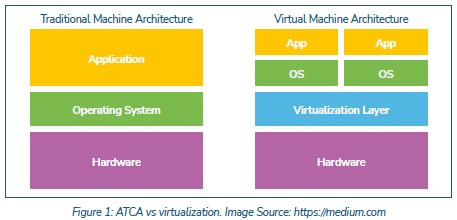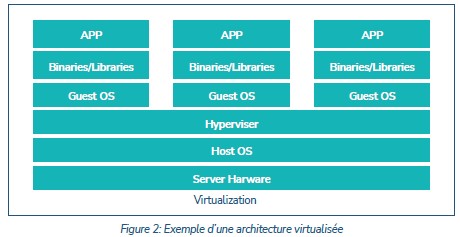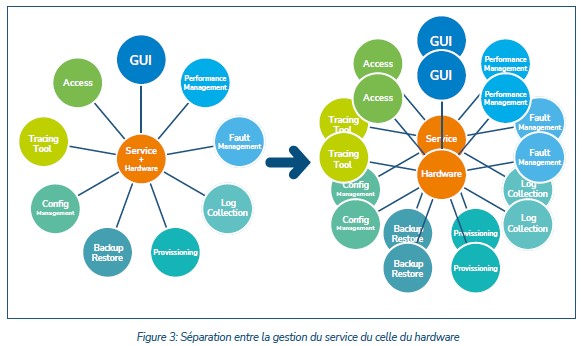Case study: Virtualization of core network equipment
About a decade ago, network equipment vendors began developing virtualized solutions. When they ended maintenance contracts for traditional ATCA and bare metal solutions, operators were pushed to migrate their networks to the cloud. Notably, projects replacing core network equipment with virtualized solutions are already yielding valuable insights.
ATCA: Replacing proprietary hardware
Introduced in the 2000s as a replacement for proprietary hardware requiring dedicated cards and servers, the Advanced Telecom Computing Architecture (ATCA) network design pledged a scalable, modular, and vendor-neutral solution.
While it partially fulfilled its pledge, with major core network equipment (MSC, SGSN, HLR, HSS, IMS) embracing ATCA, interoperability issues persisted, as cards from one manufacturer were typically only compatible with racks from the same vendor.
Scalability was indeed achievable, often constrained by the number of sub-racks within 2 or 3 bays, offering operators the flexibility to tailor the product’s physical dimensions and capacity.
Hardware malfunctions were easily identifiable and remedied through card reboots, physical interventions, or part replacements.
ATCA’s modularity stemmed from a clear division of physical connection, application protocol, service, and database cards, along with operation and maintenance cards.
Transitioning to the cloud promised to enhance this solution in various operational aspects, yet simplicity remained a challenge, as expected.
Cloud migration complexity
When operators shifted to the cloud, they realized that virtualization did not mean less hardware but rather more capacity within a highly complex platform spread across numerous virtual servers.

An example of migration to the cloud involves replacing a complete ATCA solution, which had a capacity of 3 million users, with a virtualized solution capable of accommodating 5 million telephone subscribers. Meaning that:
• The cloud solution consists of 10 servers, a storage bay, and several routers. In total, it comprises of 50 Linux virtual machines installed on a physical infrastructure consisting of 10 servers.
• Multiple graphical user interfaces (GUIs) and command-line interfaces (CLIs) are needed for various components: the 10 physical servers, the operating system of the 50 VMs, the virtualization module, the performance collector, and a ‘satellite’ server responsible for checking Linux licenses online. In ATCA, each card functioned as a server, with a single unified graphical interface for managing performance, security, alarms, and configuration.
• Dedicated cables are no longer required. There’s no need to label cables for specific types of traffic, as inter-server fibers now transport all traffic between machines and internal equipment without discrimination.
• All hardware and maintenance of physical servers have been entrusted to the infrastructure team (IT).
Following a few years of reflection, it appears that the service functions effectively, capacity is assured, and the operator has mastered the architecture and operation of the new platform.
Due to cloudification, a cluster of servers has replaced a set of cards that performed well-defined tasks and communicated with each other via internal buses. Each server is based on a Linux operating system that shares resources with other servers in the cluster. An orchestrator server synchronizes the resources of the many virtual machines spread across the physical servers. To achieve a high level of optimization in processing access, connectivity, or service management tasks, it is necessary to rely on very powerful physical machines, a fast internal communication network, and synchronization software.

Pros of cloudification
Despite its hardware complexity, cloudification optimizes network operations:
• It enhances capacity across various metrics, such as the number of subscribers, queries per second, bandwidth, or throughput. Additionally, it optimizes resource utilization and task processing. Ultimately, a dozen physical servers can deliver significantly greater capacity compared to a non-virtualized system.
• It impacts simplicity due to a clear separation between installed hardware and the applications running on it. Telecom teams no longer must maintain hardware, which is now entrusted to IT teams. They can focus on the service and the software aspect, which is now much more powerful.
• Scalability is guaranteed by the orchestration function— as new physical servers host increasing numbers of virtual machines, additional resources are introduced.
• The notion of modularity disappears since modules are now virtual machines distributed across physical servers. It is no longer possible to unplug a telecom card to replace its hard drive, as done in the past.
• Operation and Maintenance (O&M), known for its resilience, remains steadfast amid change. The transition to the cloud still depends on alarms generated by various platform layers (physical, IT, virtual, and application layers), while the performance system generates service and hardware measurements in distinct systems. Although operators prefer a centralized and unified O&M system, there’s a shift towards segregating the graphical interface for telecom service management from the hardware maintenance management interface, as the latter has become notably intricate.
• By maximizing processor synchronization instead of physical extensions, cloudification reduces the operator’s energy consumption.

All operators are currently involved in the cloudification process, which adds complexity to architecture, raises concerns, and reshapes roles. Nonetheless, amidst the rising demand for usage, embracing new technologies offers a tangible solution for enhancing capacity.
Up page:Case Studies: Xen, VMware, Microsoft Hyper-V
Down Page:Hyper-V Technology Overview
 Pre Sales:Mr.Qian
Pre Sales:Mr.Qian
